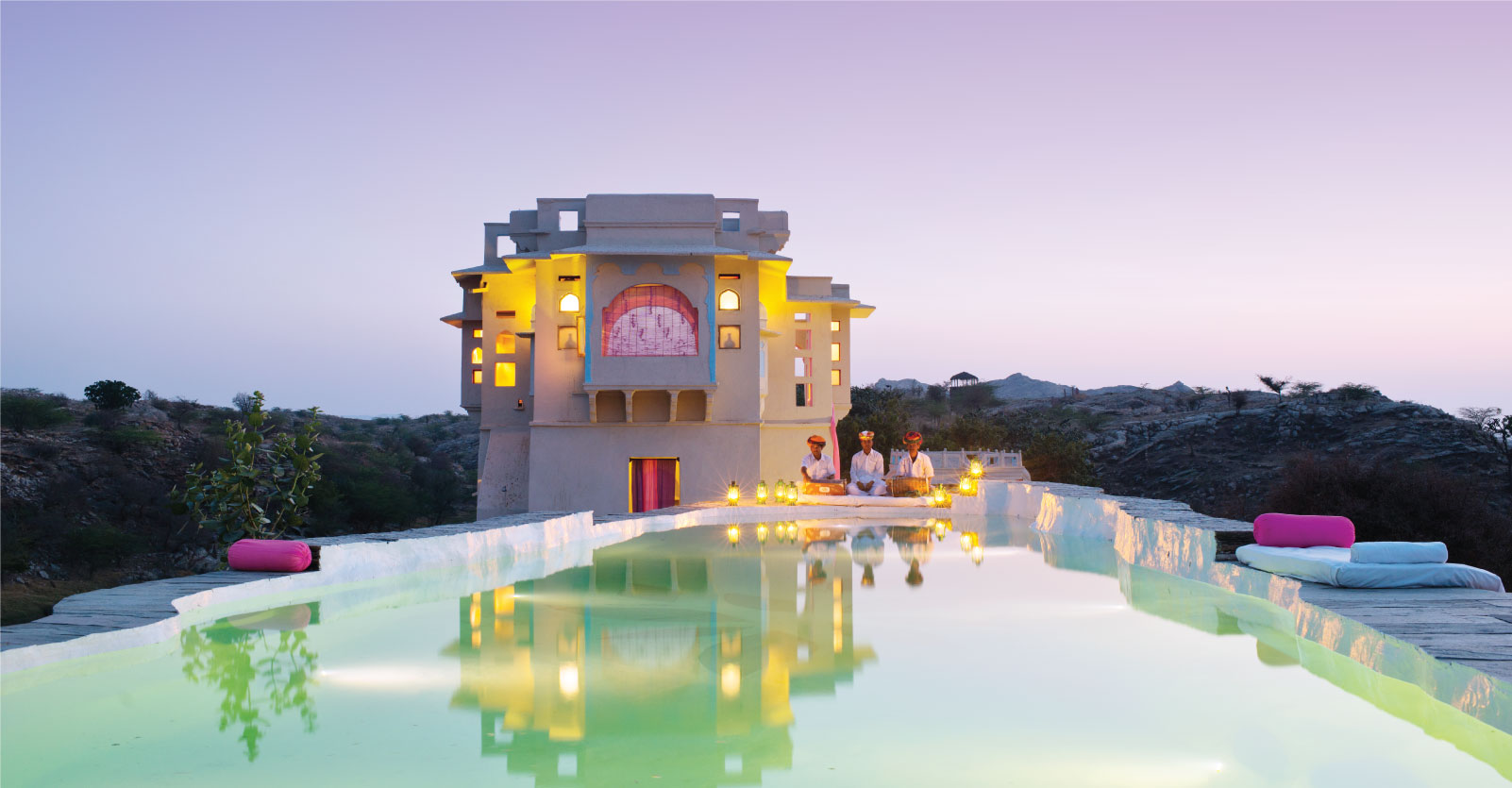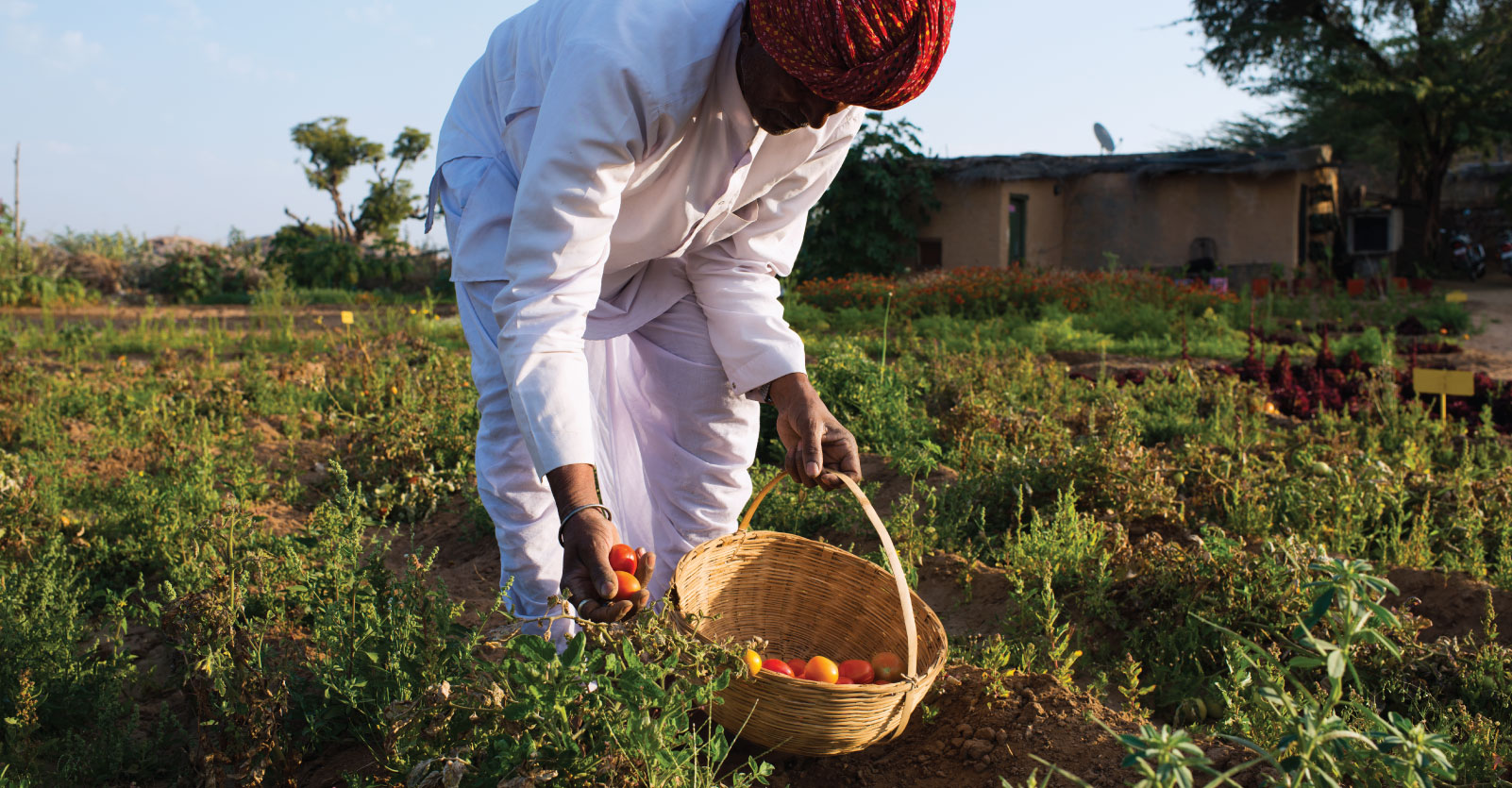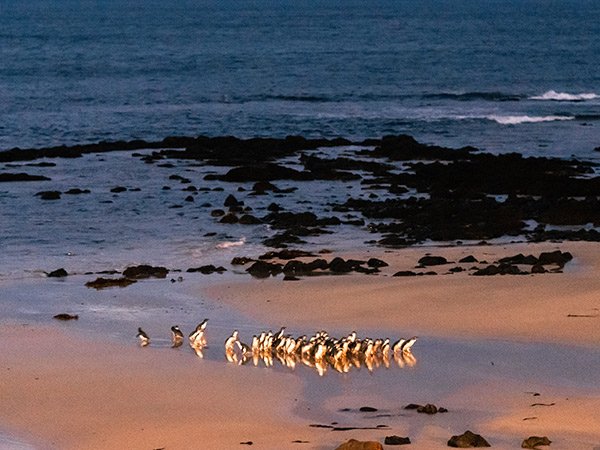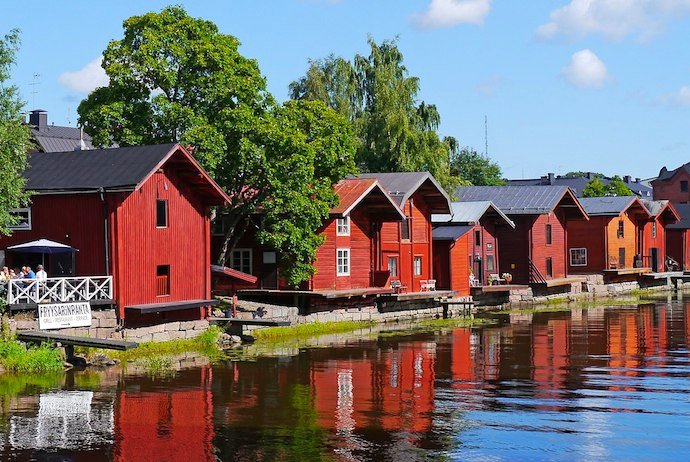My first memories of Rajasthan are tied up with golden mustard fields, turmeric hills and a slobbering water buffalo. It was the mid-1990s, and I was a graduate student investigating heirloom millet seeds—the region’s primary grain crop—and living in an unfinished brick house on the outskirts of Jhunjhunu, back then a dusty market town clamoring with chai and sabji wallahs, metalsmiths, rickety bicycles, camel carts and listless cows. My hosts Phoolchand Dhewa and his wife Ram Kauri put me up in a closet-sized room outfitted with a charpoy—a narrow wooden frame bench strung with thick woven rope—and a light, homemade razai or quilt stuffed with cotton and wool. The room’s only window opened onto a scrappy manger belonging to Kaveri, the family’s stocky milking buffalo. A steadfast roommate, Kaveri nuzzled me awake at dawn, right before milking time when colorfully dressed village ladies balancing metal pots on their heads arrived to buy milk.

Ranvas at Nagaur is built into the former quarters of the maharajas concubines. Ranvas Nagaur & Mehrangarh Museum Trust.
By day, Phoolchand and I traipsed the countryside, a patchwork of waist-high millet and mustard fields broken up here and there by the encroaching Thar Desert, which blankets the state’s western hinterland. Sitting cross-legged under the shade of peepal trees in the maidan, or village square, I interviewed farmers who explained the challenges of rural living and the steady creep of modernization. Clad in teetering magenta or saffron turbans and sporting well-coiffed moustaches—Rajasthani menfolk equate a well-groomed handlebar with virility—these farmers took their hand-to-mouth livelihood in stride, grinning broadly and serving tray after tray of sweet masala chai, tangy yogurt lassi and homemade jaggery so caramel-y it would make millennial foodies swoon.
In the evenings, I huddled in the outdoor kitchen shack with Ram Kauri, helping her put together a one-pot curry of homegrown spices, lentils and vegetables cooked in earthy mustard oil, which she hand-pressed with a medieval-looking grinding stone. Then, we rolled the faintly blue bajra or millet rotis and cooked them over a slow-burning wood fire, piling them up one on top of another until there was enough for everyone. Eating with them by candlelight, my heart swelled with happiness. It was simple living, but it felt like a life of kings.

Heritage room at Alila. Courtesy of Alila Fort Bishangarh

The rock-cut pool of Lakshman Sagar by Sewara Courtesy of Lakshman Sagar by Sewara

Narendra Bhawan Bikaner Courtesy of Narendra Bhawan Bikaner
In fact, Rajasthan means “land of kings.” Straddling India’s western border with Pakistan and sitting at the junction of ancient caravan routes, this region was for centuries ruled by factions of the Rajput clan—noble warriors who knew how to fight hard and live well. The Rajputs left behind a trail of blood-stained battlefields, imposing fortresses, lavish palaces and pleasure gardens that emerge like mirages on blistering desert horizons. Once India gained independence, however, Rajput royals were stripped of their titles and gradually turned their palatial digs into heritage hotels, giving travelers a taste of decadent maharaja living. When I left Phoolchand and Ram Kauri’s home, I treated myself to a stay in a handful of them. No doubt, the palace interiors were drop-dead gorgeous with their exuberant frescoes, marble and gem-encrusted chambers, embroidered canopy beds and reams of luscious silks and brocades. I relished the pomp and frills, the platoon of servants and, of course, the hot showers. But, often the experiences lacked soul. The honest, unbridled hospitality and bravura of the Rajput personality had been scrubbed out, and I found myself desperately missing the heartwarming community in the countryside and the buffalo Kaveri’s muzzle and drool. Over the years, I kept going back, hoping that my fondness for authentic royal and rural Rajasthani culture could somehow merge. For years, I came away disappointed, and then, on my most recent trip, I stumbled upon a few hidden-in-plain sight venues that were quietly resuscitating Rajasthani spirit. And, miraculously, they nailed it.
THE ORIGINAL HERITAGE hotels were authentic, but then it became overcooked,” historian-turned-hotelier Dhananajaya Singh explains as we sip nimbu pani, or lemonade, in Baradari, the courtyard restaurant of RAAS Jodhpur, a pioneering heritage hotel and urban renewal project that Singh and his brother Nikhilendra launched in Jodhpur, the famous 15th-century walled city in western Rajasthan. The turning point came when India’s top contemporary art collector, Lekha Poddar, renovated Devigarh, her palace residence in Delwara, a picturesque hamlet on the outskirts of Udaipur. Poddar embraced the original architectural mood, but threw out the crewel and chintz, introduced clean, minimalist lines, incorporated modern furniture and whittled away outdated conventions, like small doors and windows. “When you place contemporary elements inside 500-year-old spaces, it creates a dialectic that is intriguing,” Singh tells me. “It’s really the only way to move forward.”

RAAS Jodhpur’s scenic restaurant. Courtesy of RAAS Jodhpur.
Strolling through RAAS Jodhpur, which includes the hotel and an ambitious urban renewal project called Stepwell Square — a renovated 18th-century stepwell surrounded by smart boutiques and eateries — Singh’s point becomes clear. The main hotel’s 39 rooms and suites, pillared dining halls and cozy lounge alcoves occupy a mix of 18th century havelis, traditional urban dwellings built around a central courtyard, stables and temple, and three contemporary buildings. Old-world artisans were called in to restore the original jali (perforated wall screens), jharokha (overhanging enclosed balconies), carved rose sandstone pillars and copulas. New structures, like the Garden Wing rooms, parse minimalist luxury with steel and glass touches, contemporary furniture and a diehard eco- philosophy—no plastic bottles, water-efficient taps and a fun, electric scooter to zip around town. Vertical slits in the façade, a twist on the classic jali, freckle the interior courtyards with dappled light. “Doors and windows didn’t need to be small anymore,” Singh says as he swings open a window in the pretty garden suite and reveals hands-down Jodphur’s best view of the 15th-century Mehrangarh Fort, the former residence and garrison belonging to the Jodhpur maharajas, which looms high above the walled city. “We’re not worried about armies storming in or keeping the heat out,” he laughs.
Once the hotel was completed, the brothers set to work on the adjacent toorji ka jhalra, or Stepwell Square as it’s known today. The architecturally mesmerizing stepwell, whose staggered flights of steps descend nearly 50 meters into blue water, was once a vital source of water for the parched city. Back in the day, before there was indoor plumbing, women would come here to collect water, worship, run errands and, no doubt, catch up on gossip of the day. Today, however, the stepwell is like an urban park, a shady rest stop for folks to catch up and chill. The brothers updated the pretty havelis surrounding the stepwell and filled them with charming boutiques and eateries, including India’s top clothing and lifestyle labels such as Nicobar, Play Clan, Stepwell Café, Rajesh Pratap Singh, and Andraab to name a few.
Perched on the edge of toorji ka jhalra, I take in the scene. Jodhpur is Rajasthan’s second largest city, but it lives and breathes like a village. RAAS Jodhpur and Stepwell Square sits in the midst of cacophonous network of narrow winding lanes, centuries-old grain and spice markets, artisan guilds and quaint, blue- tinted shophouses and temples—the blue keeps the heat and insects away—and lays at the feet of Mehrangarh Fort, the city’s main focal point. Watching locals and visitors stream in and out of the Square, taking selfies or simply chilling, I realize Singh and his brother had inadvertently flipped things around. They took Jodhpur’s lofty royal legacy, which is inextricably bound up in the fort 120 meters overhead, and brought it down to earth.
CRUISING THE RAJASTHANI hinterland, I encounter similarly inspiring and forward-thinking heritage projects. The Alila Fort Bishangarh, for example, is mounted on a granite bluff, but remains connected to the pastoral vibe of the Bishangarh village below. Alila built new structures on the Fort’s original footprint, creating regal suites inspired by old Rajput and Mughal flourishes like Tarkashi, brass inlaid in wood, and frescoes with Thikri mirror work. There’s plenty of new-age fusion at the tony Amarsar dining room and vigorous gin and whiskey tonics at the clubby Madhuveni lounge, yet the best experiences here are all about indigenous gastronomy. My excitement peaks when the hotel’s chef gives me a tutorial on braai, a nomadic-inspired style of grilling marinated mutton over an open flame. Rajasthani cuisine evolved on the go, a mix of foraging and folding in Silk Road influences; in other words, whatever warriors and traders could get their hands on. I remember Ram Kauri’s throw-it-all-in curries, and it suddenly makes sense.

Alila Fort Bishangarh. Courtesy of Alila Fort Bishangarh.
In Bikaner, a former princely state founded in 1488, Narendra Bhawan Bikaner riffs the swinging, smoking jacket–wearing and polo-playing lifestyle of a modern maharaja and his subjects. Light, playful interiors pair colonial and Midcentury pieces with ochre Bikaner terrazzo, imported Portuguese tiles and artisan indigo textiles and crafts.
Over in Nagaur, an ancient caravan crossroads rooted in a strong Sufi tradition, I find medieval and modern sentiments perfectly intertwined in Ranvas, whose 27 charming havelis, once the quarters of the maharaja’s concubines, occupy a cozy niche within 12th-century Ahhichatragarh Fort, a sprawling complex of pleasure palaces, gardens and darbars, or meeting halls.

Narendra Bhawan Bikaner. Courtesy of Narendra Bhawan Bikaner.
Then, there is Le Prince Haveli, an extravagant mid-19th-century merchant’s residence in a middle-of-nowhere crossroads deep in Shekhawati, an eastern district known for its extravagant frescoes-adorned havelis, where I help an international restoration team remove the detritus and oxidation covering the building’s hundred-year-old walls. Run by French artist Nadine Le Prince, the lavish vintage rooms and garden courtyards revel in a 19th-century merchants’ sybaritic, sheesha-smoking habits, but the vibe is quintessential French joie de vivre muddled with folksy Rajasthani humor and hospitality—think DJ beats and never-ending chai and samosa breaks. Meanwhile, Devigarh, the palace residence that jump-started this next generation of heritage hotels, continues to trailblaze—this time around as RAAS Devigarh, where the Singh brothers impeccably cleave contemporary and nostalgic sentiments in everything from the furniture to the food.
I AM STILL LOOKING FOR A throwback to my time with Phoolchand, Ram Kauri and Kaveri the nosy beast when I stumble across Lakshman Sagar by Sewara, a former 19th-century hunting lodge-turned-luxury eco-farm-stay tucked in the countryside between Pushkar and Pali, and my heart swells.

The eco-chic spa at Lakshman Sagar by Sewara. Courtesy of Lakshman Sagar by Sewara.
“Rural Rajasthan is suffering from a feudal hangover,” says Inderpal Kochhar, a filmmaker who moonlights as the founder of Sewara, a slow-life-inspired company that lifted Lakshman Sagar from ruin. The heritage hoopla only touches on a “thin creamy layer of Rajput life,” he continues. “I wanted to explore the other part of our heritage, the one that is rooted in Rajasthan’s agrarian and tribal past.” Sprawled across 13 hectares of scrubland wilderness and built around a tranquil lake, the property features 12 hand-hewn, ecologically conceived mud and stucco cottages and two restored havelis—the Zanana and Mardana where the Thakur of Raipur hosted hunting expeditions during the British Raj. During the renovation, Kochhar pursued a “zero-kilometer” ethos, wherein everything—be it the eucalyptus beam inside the cottages, the sarkhanda and kheep grasses shading the lakeside gazebos, or the spices and vegetables used in the kitchen—not only came from surrounding villages but drew on local artisan skills and problem-solving. In spite of using simple, local materials, Kochhar has inculcated a luxurious mien fit for kings.
Chilling in my lakeside cottage—each comes with its own plunge pool—I watch wild antelopes and boars mosey up to the lake, while royal blue kingfishers, cormorants and egrets lap the shoreline. I take long walks around the property, traversing narrow ravines and climbing million-year-old boulders studded with quartz and obsidian. On the Zanana’s rooftop terrace, I linger with sweet masala chai, watching tawny sunrises light up the rangy hillsides. In the Mardana’s breezy veranda, I savor local farm grub like khejri, guggal and raabri, curries made with dried, herbaceous leaves and seeds. In the nearby village, I shape clay bowls with the village potter, corral goats with a tribal Rabari herder (it’s harder than it looks), wait patiently while a wizened, turbaned cobbler draws an outline of my foot on a piece of paper and uses it to craft a handsome pair of camel-leather juttis, or Rajasthani loafers. There is even a local hooch-maker, distilling an anise-flavored liquor called saunf made from fennel seeds.

Garden- fresh fare in Lakshman Sagar by Sewara. Courtesy of Lakshman Sagar by Sewara.
Kochhar half-jokingly calls this swathe of Rajasthan the Badlands. “It’s like the Wild West out here. The survivalist, frontier spirit is deeply ingrained,” he says. He was right. The folks I met embodied Rajasthan’s noble, strident and humble spirit. A good-natured lot, much like Phoolchand and Ram Kauri, they indulged in the simple pleasures of the here and now and were living a life just as compelling as the maharajas.
RAJASTHAN
India is known for its opulent five-star hotel service. But in Rajasthan, set your sights on smaller brands whose pitch- perfect stays in historic surrounds define the term unique.
Getting There
Jaipur Sanganer International Airport has nonstop flights from Bangkok and Kuala Lumpur. Tourist e-visas can be obtained online prior to arrival at indianvisaonline.gov.in.
Rajasthan’s modern road network makes it feasible, and enjoyable, to do a leisurely road trip. I hired a car and driver through India Beat (indiabeat.co.uk). Most luxury hotels in India offer complimentary driver accommodations.
Hotels:
RAAS Jodhpur Set against the backdrop of the towering Mehrangarh Fort, the glassy blue infinity pool was a cool spot to unwind after a day of exploring, as is the decadent spa with its excellent Ayurvedic and Himalayan treatments, like the Tibetan Ku Ny, which realigned my sensory organs. raasjodhpur.com; doubles from US$315.
Lakshman Sagar by Sewara Traditional charpoys made cozy with soft hot-pink cushions flank the aquamarine swimming pool, dug right into an ancient granite boulder. An indigenous body treatment in the quirky and delightful spa, housed in a water tower, used Multani mitti, local clay, making my skin soft and silky for days. sewara.com; doubles from US$315
RAAS Devigarh Eclectic curated experiences ferried me to sacred temples—where I learned to do darshan, or offer holy prayers—and to village guilds, including Sadhana Workshop, a fair-trade studio with fabulous clothes and crafts. raasdevigarh.com; doubles from US$308.
Alila Fort Bishangarh Don’t be fooled by Spa Alila’s dungeon locale! The treatments are heavenly, especially the Roots of Jaipur which purifies the skin with field-grown turmeric, gram seed and mustard oil. alilahotels.com; doubles from US$400.
Narendra Bhawan Bikaner The Merchant Experience flung me back in time as I explored old markets lined with caravanserais, where traders from around the world stopped in to hustle exotic textiles, ceramics and spices. narendrabhawan.com; doubles from US$115.
Ranvas at Nagaur Guests have the run of the fort—whose walls have a built-in walking path, offering a bird’s-eye view of the town’s donkey, sheep and rickshaw–trafficked market lanes and gorgeous sunsets. ranvasnagaur.com; doubles from US$250.
Le Prince Haveli The atmospheric vibe here is hard to beat, but I equally enjoyed poking around the medieval marketplace village lanes lined with crumbling, half-buried havelis with jaw-dropping frescoes. leprincehaveli.com, doubles from US$50.

